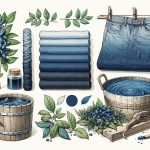Have you ever wondered how denim fabric is made? Well, wonder no more! In this article, we will take you on a journey through the fascinating process of creating this iconic fabric.
From the history of denim to the raw materials used, from spinning and weaving to the indigo dyeing process, and finally, the finishing techniques employed – we will explore every step that goes into making denim.
So, get ready to discover the secrets behind your favorite pair of jeans!
Table of Contents
History of Denim Fabric
Denim fabric has a rich history that dates back to the 19th century. Over the years, denim has evolved from being a sturdy workwear material to becoming a staple in fashion. The evolution of denim fashion can be traced back to the 1950s, when it gained popularity among rebellious youth and was associated with iconic figures like James Dean and Marlon Brando. Since then, denim has become a versatile fabric, being used for various clothing items such as jeans, jackets, and skirts.
However, the production of denim has a significant environmental impact. The process of making denim involves the use of large amounts of water, chemicals, and energy. The dyeing process, in particular, contributes to water pollution as the indigo dye used in denim production is toxic and can harm aquatic life. Additionally, the production of denim requires the cultivation of cotton, which is a resource-intensive crop that often relies on pesticides and fertilizers.
To address these environmental concerns, there have been recent innovations in denim production. Sustainable practices, such as using organic cotton, recycling water, and using eco-friendly dyes, are being adopted by some denim manufacturers. Furthermore, there is a growing trend of upcycling and repurposing denim, reducing the need for new fabric production.
Raw Materials Used in Denim Production
Cotton and indigo dye are essential materials in creating the popular fabric. In denim production, the fiber selection plays a crucial role in determining the quality and durability of the final product. Cotton, a natural fiber, is the primary material used in denim fabric. It is known for its strength, breathability, and ability to hold color. When selecting cotton fibers for denim production, factors such as fiber length, strength, and fineness are considered to ensure the fabric’s durability and comfort.
Once the cotton fibers are selected, the manufacturing process begins. First, the fibers are cleaned and carded to remove any impurities and align them in a parallel manner. This process creates a thin web of cotton fibers, known as a carded sliver. The sliver is then fed into spinning machines, where it is twisted and drawn into yarns. These yarns are then dyed using indigo dye, which gives denim its characteristic blue color.
After dyeing, the yarns are woven on looms to create the denim fabric. The weaving process interlaces the yarns in a specific pattern, creating a sturdy and durable fabric. Once the fabric is woven, it undergoes various finishing processes, such as sanforization and mercerization, to enhance its strength, appearance, and comfort.
Spinning and Weaving Process
To create the yarns for your favorite blue fabric, the fibers are twisted and drawn into yarns using spinning machines. This is an essential step in the fabric construction process. Before the fibers can be spun, they undergo fiber preparation, which includes carding and combing. Carding aligns the fibers and removes any impurities, while combing further refines the fibers by removing shorter ones. Once the fibers are prepared, they are fed into spinning machines, where they are twisted and drawn out into long, continuous strands of yarn. These yarns are then ready to be woven into fabric.
In the spinning process, the fibers are transformed from loose, individual strands into strong and durable yarns. The spinning machines play a crucial role in this transformation, as they apply tension and twist to the fibers, creating cohesion and strength. The resulting yarns can vary in thickness, depending on the desired fabric weight and texture.
The table below illustrates the key steps in the spinning and fabric construction process:
| Step | Description |
|---|---|
| Fiber Preparation | Carding and combing the fibers to remove impurities |
| Spinning | Twisting and drawing fibers into continuous yarns |
| Weaving | Interlacing yarns to create fabric |
| Dyeing | Coloring the fabric to achieve desired shade |
| Finishing | Treating the fabric to enhance its appearance and feel |
The Indigo Dyeing Process
The indigo dyeing process involves immersing the yarns in a specially prepared bath of indigo dye, which gives them their distinctive blue color. Indigo dyeing techniques have been used for centuries to create beautiful blue textiles. The history of indigo dyeing dates back thousands of years, with evidence of its use found in ancient civilizations such as Egypt and India. In these early times, indigo dye was derived from plants and extracted through a labor-intensive process. Today, synthetic indigo dye is commonly used, making the process more efficient and cost-effective.
To begin the indigo dyeing process, the yarns are carefully prepared by removing any impurities and ensuring they are evenly wetted. They are then immersed in the indigo dye bath, where they undergo oxidation and reduction reactions that allow the dye to bind to the fibers. This process is repeated multiple times to achieve the desired depth of color. After each immersion, the yarns are allowed to oxidize in the air, which causes them to turn from green to blue. The final step involves rinsing and drying the dyed yarns, resulting in the vibrant blue color that is characteristic of indigo-dyed fabrics.
The indigo dyeing process is an important part of creating denim fabric, as it gives it its iconic blue hue. Understanding the history and techniques behind indigo dyeing adds to the appreciation of the craftsmanship and artistry that goes into making denim.
Finishing and Treatment Techniques in Denim Production
You can achieve a variety of finishes in denim production through different treatment techniques. One popular technique is distressed denim, which gives jeans a worn, aged look. This can be achieved through methods such as sanding, scraping, or using chemical treatments to create fading and fraying effects. These techniques add character to the denim and give it a unique, vintage appearance.
In recent years, there has been a growing demand for sustainable denim treatments. Manufacturers are now exploring more eco-friendly options to reduce the environmental impact of the production process. Some sustainable techniques include laser fading, ozone washing, and using organic or recycled materials for finishing.
Laser fading is a precise and efficient way to achieve a faded look. It uses a laser beam to remove the indigo dye from specific areas, creating a distressed effect without the need for chemicals or excessive water usage. Ozone washing is another sustainable technique that reduces water and chemical consumption. It involves using ozone gas to bleach and fade the denim, resulting in a lighter, more worn-in look.
Conclusion
So, there you have it! Now you know how denim fabric is made.
From its humble beginnings as a sturdy workwear material to its current status as a fashion staple, denim has come a long way.
The process involves sourcing raw materials, spinning and weaving the fabric, dyeing it with indigo, and applying various finishing techniques.
This combination of craftsmanship and technology results in the durable and versatile denim fabric that we all know and love today.
Keep rocking those jeans!
- A Crafter’s Guide to Kona Cotton Fabric by the Yard, Bolt, and Precuts - June 20, 2025
- Kona Snow vs. White: Which Fabric Shade Is Right for Your Project? - June 20, 2025
- Where to Buy Kona Cotton Fabric: An Online and In-Store Guide - June 20, 2025




